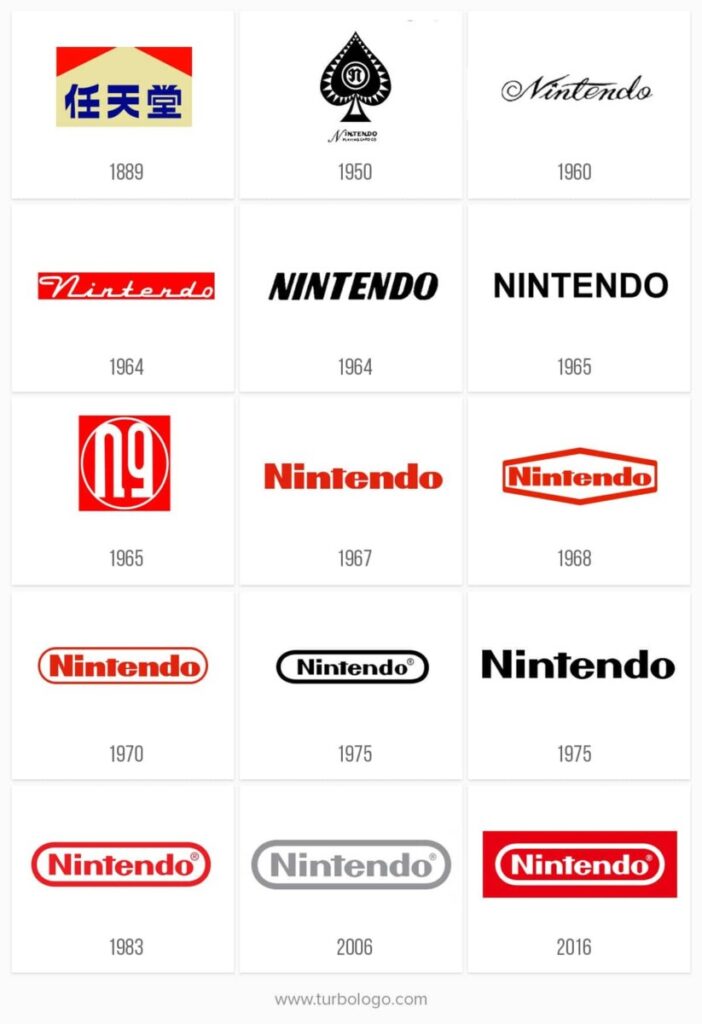
The year is 1889, Kyoto Japan is the birthplace of a man known as Fusajiro Yamauchi. It is also the birthplace of a company that we know today as one of the biggest entertainment companies known as Nintendo. From memorable games like Super Mario and Donkey Kong to entertainment systems such as the NES, SNES, Wii and finally the most recent, The Nintendo Switch. However the company wasn’t always a video game entertainment based entity, in fact at one point it made cards. These were called Hanafuda cards also known as Japanese playing cards. Forty Eight cards, divided into twelve suits of four cards. Each suit of cards represents a month of the year with flowers that are commonly shown with that month. During this time the logo was quite different to the one we know as the Nintendo Logo, as it is now the logo is what is known as a word mark. However it wasn’t always like that. In fact it changed quite a bit but a word mark is where it all began. The characters on the very first word mark had a meaning which was taken differently by many people but the basic meaning that everyone can come to agree upon is “Leave fate to heaven” or “Leave luck to heaven.” This being the case the story of Nintendo is one quite similar to this as no one would’ve guessed that it would go so far. The cards were often used to play games of luck therefore giving the reasoning as to why the logo means what it means however, when said out loud the characters say Nintendo. Nintendo playing cards is where it all began. Now through all of my research I have not found a sole person responsible for taking credit for the concept nor design for any of the logos. Which made things very difficult to say the least especially when this paper is to be about the history of the logo and the details pertaining to the conception of it. Nintendo has always been a company to innovate and try to find new things to keep itself afloat. Fusajiro had no male heir to his company therefore he had to adopt his son in law as in Japanese culture at that time the male heir must carry on the family legacy and only a male heir is able to do so. Fast forward to 1950 Hiroshi Sekiryo’s grandson, Sekiryo is Fusajiro’s son-in-law- would take over the company as the third president of Nintendo, Now why is this important? Well you see he had many western influences and wanted the best for his family’s company so he came in swinging doing mass layoffs and producing western style plastic cards and even having a deal with Walt Disney company to produce western style playing cards with all time memorable characters on them. During the 60s Nintendo hit a snag in their business model and needed to change it up a whole lot in order to try to survive and their logo would change as well almost mimicking their actions the logo looked very different and was overall the most outside looking logo. This was caused by the adult market changing and after a while of investing and love hotels the company settled with the child market with toys and the start of their video games. From this point forward the logo goes through a wide variety of changes in order to try and find their footing along with this Nintendo begins to make a name for themselves in the world as a video game company with many different big names being invented such as Jumpman who would later become Mario and Donkey Kong. Resulting in a very recognizable logo, the 1983 red letter and white background logo. This logo hasn’t really been challenged, the most is that time during the 2000s to mid 2010s where it was gray but that was mainly seen on Wii products as I still have mine
and they show the gray version of the 1983 logo. Now the most recent logo is just the inverse of the 1983 logo. The reason for all of this is to say that this company has been around for over 100 years and won’t be going anywhere anytime soon, Fusajiro left his fate and luck to the heavens and he went from being the best hanafuda maker in all of Japan to being the first ever President of a multibillion dollar company that still sells his traditional Hanafuda cards.
Works Cited:
Admin, Joe – LMW. “Joe – LMW Admin.” LogoMyWay, 11 Nov. 2020, blog.logomyway.com/nintendo-logo/.
Wwwsrc.nintendo.com. wwwsrc.nintendo.com/consumer/downloads/hanafuda_en.pdf.



